Hyundai Sonata: Air bag - advanced supplemental restraint system
 Hyundai Sonata: Air bag - advanced supplemental restraint system
Hyundai Sonata: Air bag - advanced supplemental restraint system
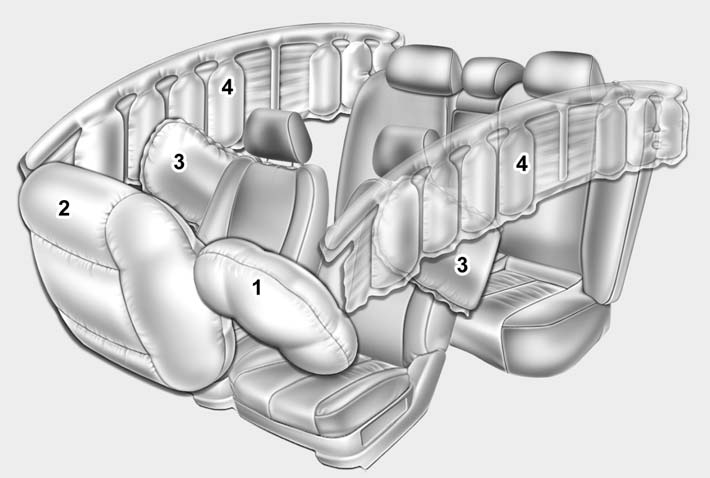
* The actual air bags in the vehicle may differ from the illustration.
(1) Driver’s front air bag
(2) Passenger’s front air bag
(3) Side impact air bag
(4) Curtain air bag
WARNING
Even in vehicles with air bags, you and your passengers must always wear the seat belts provided in order to minimize the risk and severity of injury in the event of a collision or rollover.
- How does the air bag system operate
- Air bag warning light
- SRS components and functions
- Occupant classification system
- Driver's and passenger's front air bag
- Side impact air bag
- Curtain air bag
- Why didn’t my air bag go off in a collision? (Inflation and non-inflation conditions of the air bag)
- Air bag inflation conditions
- Side impact and curtain air bags
How does the air bag system operate
• Air bags are activated (able to inflate if necessary) only when the ignition
switch is turned to the ON or START position.
• Air bags inflate instantly in the event of serious frontal or side collision in
order to help protect the occupants from serious physical injury.
• There is no single speed at which the air bags will inflate.
Generally, air bags are designed to inflate by the severity of a collision and its
direction. These two factors determine whether the sensors sendout an electronic
deployment/ inflation signal.
• Air bag deployment depends on a number of factors including vehicle speed, angles
of impact and the density and stiffness of the vehicles or objects which your vehicle
hits in the collision. Though, factors are not limited to those mentioned above.
• The front air bags will completely inflate and deflate in an instant. It is virtually
impossible for you to see the air bags inflate during an accident. It is much more
likely that you will simply see the deflated air bags hanging out of their storage
compartments after the collision.
• In order to help provide protection in a severe collision, the air bags must inflate
rapidly. The speed of air bag inflation is a consequence of the extremely short
time in which a collision occurs and the need to get the air bag between the occupant
and the vehicle structures before the occupant impacts those structures. This speed
of inflation reduces the risk of serious or lifethreatening injuries in a severe
collision and is thus a necessary part of air bag design. However, air bag inflation
can also cause injuries which normally can include facial abrasions, bruises and
broken bones because the inflation speed also causes the air bags to expand with
a great deal of force.
• There are even circumstances under which contact with the air bag can cause fatal
injuries, especially if the occupant is positioned excessively close to the air
bag.
WARNING
• To avoid severe personal injury or death caused by deploying air bags in
a collision, the driver should sit as far back from the steering wheel air bag as
possible (at least 10 inches (250 mm) away). The front passengers should always
move their seats as far back as possible and sit back in their seat.
• Air bags inflate instantly in the event of collision, and passengers may be injured
by the air bag expansion force if they are not in proper position.
• Air bag inflation may cause injuries which normally include facial or bodily abrasions,
injuries from broken glasses or burns by the air bag inflation gasses.
Noise and smoke
When the air bags inflate, they make a loud noise and they leave smoke and powder in the air inside of the vehicle. This is normal and is a result of the ignition of the air bag inflator. After the air bag inflates, you may feel substantial discomfort in breathing due to the contact of your chest with both the seat belt and the air bag, as well as from breathing the smoke and powder. Open your doors and/or windows as soon as possible after impact in order to reduce discomfort and prevent prolonged exposure to the smoke and powder.
Though the smoke and powder are nontoxic, they may cause irritation to the skin (eyes, nose and throat, etc). If this is the case, wash and rinse with cold water immediately and consult a doctor if the symptom persists.
WARNING
When the air bags deploy, the air bag related parts in the steering wheel and/or instrument panel and/or in both sides of the roof rails above the front and rear doors and in the front set backs are very hot. To prevent injury, do not touch the air bag storage area’s internal components immediately after an air bag has inflated.
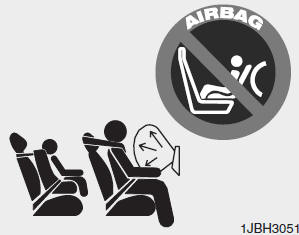
Do not install a child restraint on the front passenger’s seat.
Never place a rear-facing child restraint in the front passenger’s seat. If the air bag deploys, it would impact the rear-facing child restraint, causing serious or fatal injury.
In addition, do not place front-facing child restraints in the front passenger’s seat either. If the front passenger air bag inflates, it could cause serious or fatal injuries to the child.
WARNING
• Extreme Hazard! Do not use a rearward facing child restraint on a seat protected by an air bag in front of it!
• Never put a child restraint in the front passenger’s seat. If the front passenger air bag inflates, it would cause serious or fatal injuries.
• When children are seated in the rear outboard seats of a vehicle equipped with side and/or curtain air bags, be sure to install the child restraint system as far away from the door side as possible, and securely lock the child restraint system in position. Inflation of side and/or curtain air bags could cause serious injury or death to an infant or child.
Air bag warning light
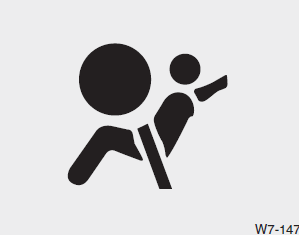
The purpose of air bag warning light in your instrument panel is to alert you of a potential problem with your air bag - Supplemental Restraint System (SRS).
When the ignition switch is turned ON, the indicator light should illuminate for approximately 6 seconds, then go off. Have the system checked if:
• The light does not turn on briefly when you turn the ignition ON.
• The light stays on after illuminating for approximately 6 seconds.
• The light comes on while the vehicle is in motion.
• The light blinks when the ignition switch is in ON position.
SRS components and functions
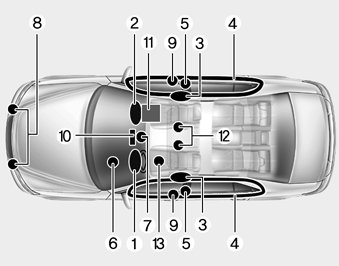
The SRS consists of the following components:
1. Driver's front air bag module
2. Passenger's front air bag module
3. Side impact air bag modules
4. Curtain air bag modules
5. Retractor pre-tensioner assemblies
6. Air bag warning light
7. SRS control module (SRSCM)
8. Front impact sensors
9. Side impact sensors
10. PASS AIR BAG “OFF” indicator (Front passenger’s seat only)
11. Occupant classification system (Front passenger’s seat only)
12. Driver’s and front passenger’s seat belt buckle sensors
13. Driver’s seat track position sensor
14. Anchor pre-tensioner
15. Side pressure sensor
The SRSCM continually monitors all SRS components while the ignition switch is ON to determine if a crash impact is severe enough to require air bag deployment or pre-tensioner seat belt deployment.
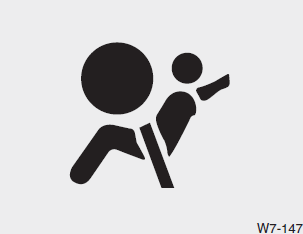
The SRS air bag warning light "  "
on the instrument panel will illuminate for about 6 seconds after the ignition switch
is turned to the ON position, after which the SRS air bag warning light "
"
on the instrument panel will illuminate for about 6 seconds after the ignition switch
is turned to the ON position, after which the SRS air bag warning light "
 " should go out.
" should go out.
WARNING
If any of the following conditions occurs, this indicates a malfunction of
the SRS. Have an authorized HYUNDAI dealer inspect the air bag system as soon as
possible.
• The light does not turn on briefly when you turn the ignition ON.
• The light stays on after illuminating for approximately 6 seconds.
• The light comes on while the vehicle is in motion.
• The light blinks when the ignition switch is in ON position.
Driver’s front air bag (1)
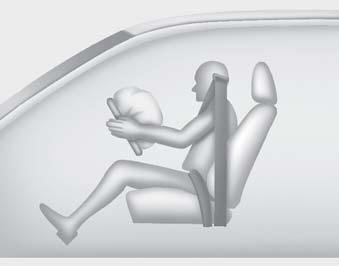
The front air bag modules are located both in the center of the steering wheel and in the front passenger's panel above the glove box. When the SRSCM detects a sufficiently severe impact to the front of the vehicle, it will automatically deploy the front air bags.
Driver’s front air bag (2)
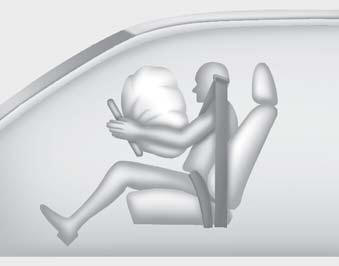
Upon deployment, tear seams molded directly into the pad covers will separate under pressure from the expansion of the air bags. Further opening of the covers then allows full inflation of the air bags.
Driver’s front air bag (3)
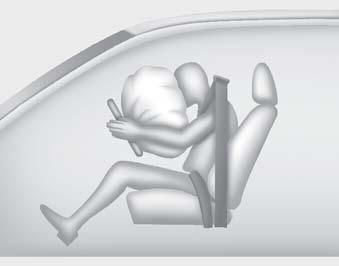
A fully inflated air bag, in combination with a properly worn seat belt, slows the driver's or the passenger's forward motion, reducing the risk of head and chest injury.
After complete inflation, the air bag immediately starts deflating, enabling the driver to maintain forward visibility and the ability to steer or operate other controls.
Passenger’s front air bag
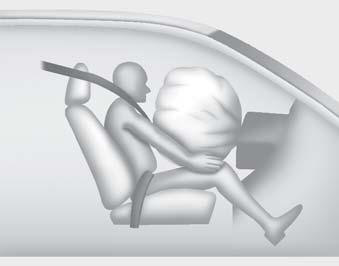
WARNING
• Do not install or place any accessories (drink holder, CD or discs holder, sticker, etc.) on the front passenger's panel above the glove box in a vehicle with a passenger's air bag. Such objects may become dangerous projectiles and cause injury if the passenger's air bag inflates.
• When installing a container of liquid air freshener inside the vehicle, do not place it near the instrument cluster nor on the instrument panel surface. It may become a dangerous projectile and cause injury if the passenger's air bag inflates.
WARNING
• If an air bag deploys, there may be a loud noise followed by a fine dust released in the vehicle. These conditions are normal and are not hazardous - the air bags are packed in this fine powder. The dust generated during air bag deployment may cause skin or eye irritation as well as aggravate asthma for some persons. Always wash all exposed skin areas thoroughly with lukewarm water and a mild soap after an accident in which the air bags were deployed.
• The SRS can function only when the ignition switch is in the ON position.
If the SRS air bag warning light "  "
does not illuminate, or continuously remains on after illuminating for about 6 seconds
when the ignition switch is turned to the ON position, or after the engine is started,
comes on while driving, the SRS is not working properly. If this occurs, have your
vehicle immediately inspected by an authorized HYUNDAI dealer.
"
does not illuminate, or continuously remains on after illuminating for about 6 seconds
when the ignition switch is turned to the ON position, or after the engine is started,
comes on while driving, the SRS is not working properly. If this occurs, have your
vehicle immediately inspected by an authorized HYUNDAI dealer.
• Before you replace a fuse or disconnect a battery terminal, turn the ignition switch to the LOCK position and remove the ignition key. Never remove or replace the air bag related fuse(s) when the ignition switch is in the ON position. Failure to heed this warning will cause the SRS air gag warning light to illuminate.
Occupant classification system
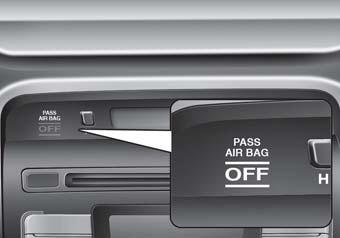
Type A
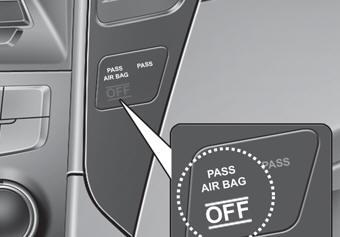
Type B
Your vehicle is equipped with an occupant classification system in the front passenger's seat.
The occupant classification system is designed to detect the presence of a properly-seated front passenger and determine if the passenger's front air bag should be enabled (may inflate) or not. The driver's front air bag is not affected or controlled by the occupant classification system.
Main components of occupant classification system
• A detection device located within the front passenger seat frame.
• Electronic system to determine whether the front passenger air bag system should be activated or deactivated.
• A warning light located on the instrument panel which illuminates the words PASS AIR BAG "OFF" indicating the front passenger air bag system is deactivated.
• The instrument panel air bag warning light is interconnected with the occupant classification system.
If the front passenger seat is occupied by a person that the system determines to be of adult size, and he/she sits properly (sitting upright with the seatback in an upright position, centered on the seat cushion with their seat belt on, legs comfortably extended and their feet on the floor), the PASS AIR BAG "OFF" indicator will be turned off and the front passenger's air bag will be able to inflate, if necessary, in frontal crashes.
You will find the PASS AIR BAG "OFF" indicator on the center facia panel. This system detects the conditions 1~4 in the following table and activates or deactivates the front passenger air bag based on these conditions.
Always be sure that you and all vehicle occupants are seated and restrained properly (sitting upright with the seat in an upright position, centered on the seat cushion, with the person's legs comfortably extended, feet on the floor, and wearing the safety belt properly) for the most effective protection by the air bag and the safety belt.
• The OCS may not function properly if the passenger takes actions which can affect the classification system. These include:
(1) Failing to sit in an upright position.
(2) Leaning against the door or center console.
(3) Sitting towards the sides or the front of the seat.
(4) Putting legs on the dashboard or resting them on other locations which reduce
the passenger weight on the front seat.
(5) Improperly wearing the safety belt.
(6) Reclining the seat back.
Condition and operation in the front passenger occupant classification system
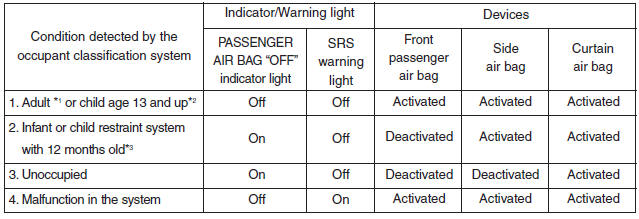
*1) The system judges a person of adult size as an adult. When a smaller adult sits in the front passenger seat, the system may recognize him/her as a child depending on his/her physique and posture.
*2) Do not allow children to ride in the front passenger seat. When a larger child who has outgrown a child restraint system sits in the front passenger seat, the system may recognize him/her as an adult depending upon his/jer physique or sitting position.
*3) Never install a child restraint system on the front passenger seat.
WARNING
Riding in an improper position or placing weight on the front passenger's seat when it is unoccupied by a passenger adversely affects the occupant classification system (OCS).
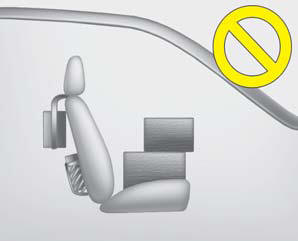
- Never put a heavy load in the front passenger seat or seatback pocket.
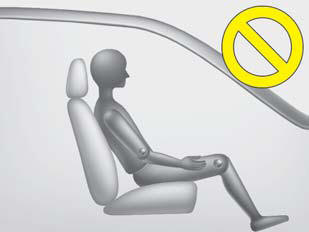
- Never sit with hips shifted towards the front of the seat.
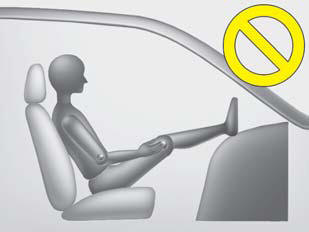
- Never place feet on the dashboard.
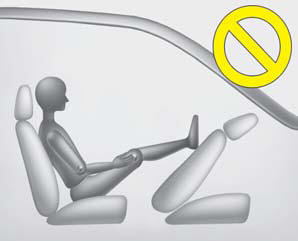
- Never place feet on the front passenger seatback.
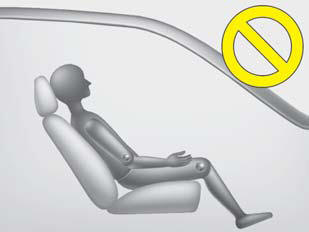
- Never excessively recline the front passenger seatback.
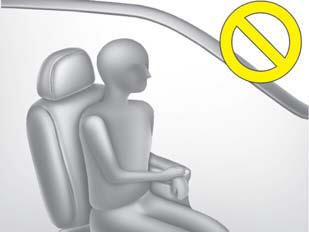
- Never lean on the door or center console.
- Never sit on one side of the front passenger seat.
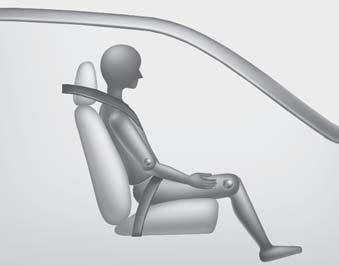
Proper position
When an adult is seated in the front passenger seat, if the PASS AIR BAG “OFF” indicator is on, turn the ignition switch to the LOCK or OFF position and ask the passenger to sit properly (sitting upright with the seat back in an upright position, centered on the seat cushion with their seat belt on, legs comfortably extended and their feet on the floor). Restart the engine and have the person remain in that position. This will allow the system to detect the person and to enable the passenger air bag.
If the PASS AIR BAG "OFF" indicator is still on, ask the passenger to move to the rear seat.
WARNING
Do not allow an adult passenger to ride in the front seat when the PASS AIR BAG “OFF” indicator is illuminated because the air bag will not deploy in the event of a crash. If the PASS AIR BAG "OFF" indicator remains illuminated after the adult passenger repositions themselves properly and the car is restarted, it is recommended that passenger move to the rear seat because the passenger's front air bag will not deploy.
Front seat passengers must stay properly seated to avoid serious injury from a deploying air bag.
NOTICE
The PASS AIR BAG "OFF" indicator illuminates for about 4 seconds after the ignition switch is turned to the ON position or after the engine is started. If the front passenger seat is occupied, the occupant classification sensor will then classify the front passenger after several more seconds.
WARNING
Do not put a heavy load in the front passenger seatback pocket or on the front passenger seat. Do not hang onto the front passenger seat. Do not hang any items, such as a seatback table, on the front passenger seatback. Do not place feet on the front passenger seatback. Do not place any items under the front passenger seat. Any of these could interfere with proper sensor operation.
WARNING
• Even though your vehicle is equipped with the occupant classification system, never install a child restraint system in the front passenger's seat. A deploying air bag can forcefully strike a child resulting in serious injuries or death. Any child age 12 and under should ride in the rear seat. Children too large for child restraints should use the available lap/shoulder belts. No matter what type of crash, children of all ages are safer when restrained in the rear seat.
• If the PASS AIR BAG "OFF" indicator is illuminated when the front passenger's seat is occupied by an adult and he/she sits properly (sitting upright with the seatback in an upright position, centered on the seat cushion with their seat belt on, legs comfortably extended and their feet on the floor), have that person sit in the rear seat.
• Do not modify or replace the front passenger seat. Don't place anything on or attach anything such as a blanket or seat heater to the front passenger seat. This can adversely affect the occupant classification system.
• Do not sit on sharp objects such as tools when occupying the front passenger seat. This can adversely affect the occupant classification system. • Do not use accessory seat covers on the front seats.
• Accident statistics show that children are safer if they are restrained in the rear, as opposed to the front seat. It is recommended that child restraints be secured in a rear seat, including an infant riding in a rear-facing infant seat, a child riding in a forward- facing child seat and an older child riding in a booster seat.
• Air bags can only be used once – have an authorized HYUNDAI dealer replace the air bag immediately after deployment.
• The occupant classification system may not work properly if water, coffee or any other liquid including rain gets on the seat. Keep the front seat dry at all times.
• Do not place an electronic device such as a laptop computer on the front passenger seat. Its electronic field may cause the OCS to switch to the "on" condition and thus allow the passenger air bag to deploy needlessly in a collision, increasing your repair costs.
• A smaller-stature adult in the front passenger’ seat who is not seated correctly (for example: seat excessively reclined, leaning on the door or center console, or hips shifted forward in the seat) can cause a condition where the occupant classification system senses less weight than if the occupant were seated properly (sitting upright with the seatback in an upright position, centered on the seat cushion with their seat belt on, legs comfortably extended and their feet on the floor).
This condition can result in an adult potentially being misclassified as a child and illumination of the PASS AIR BAG "OFF" indicator.
WARNING
If the occupant classification system is not working properly, the SRS air
bag warning light  on the instrument
panel will illuminate because the passenger's front air bag is connected with the
occupant classification system. If there is a malfunction of the occupant classification
system, the PASS AIR BAG "OFF" indicator will not illuminate and the passenger's
front air bag will inflate in frontal impact crashes even if there is no occupant
in the front passenger's seat. If the SRS air bag warning light does not illuminate
when the ignition switch is turned to the ON position, remains illuminated after
approximately 6 seconds when the ignition switch is turned to the ON position, or
if it illuminates while the vehicle is being driven, have an authorized HYUNDAI
dealer inspect the occupant classification system and the SRS air bag system as
soon as possible.
on the instrument
panel will illuminate because the passenger's front air bag is connected with the
occupant classification system. If there is a malfunction of the occupant classification
system, the PASS AIR BAG "OFF" indicator will not illuminate and the passenger's
front air bag will inflate in frontal impact crashes even if there is no occupant
in the front passenger's seat. If the SRS air bag warning light does not illuminate
when the ignition switch is turned to the ON position, remains illuminated after
approximately 6 seconds when the ignition switch is turned to the ON position, or
if it illuminates while the vehicle is being driven, have an authorized HYUNDAI
dealer inspect the occupant classification system and the SRS air bag system as
soon as possible.
Driver's and passenger's front air bag
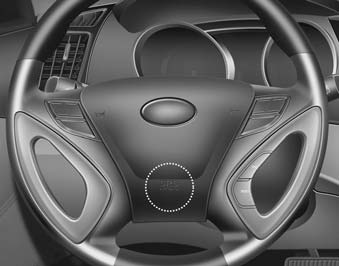
Driver’s front air bag
Your vehicle is equipped with a Supplemental Restraint (Air Bag) System and lap/shoulder belts at both the driver and passenger seating positions. The indications of the system's presence are the letters "SRS AIR BAG" or “AIR BAG" embossed on the air bag pad cover in the steering wheel and the passenger's side front panel pad above the glove box.
The SRS consists of air bags installed under the pad covers in the center of the steering wheel and the passenger's side front panel above the glove box.
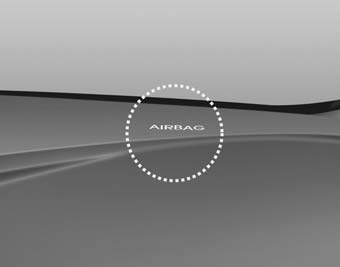
Passenger’s front air bag
The purpose of the SRS is to provide the vehicle's driver and/or the front passenger with additional protection than that offered by the seat belt system alone in case of a frontal impact of sufficient severity. The SRS uses sensors to gather information about the driver's seat position, the driver's and front passenger's seat belt usage and impact severity.
WARNING
If the occupant classification system is not working properly, the SRS air bag
warning light  on the instrument panel
will illuminate because the SRS air bag warning light is connected with the occupant
classification system. If the SRS air bag warning light does not illuminate when
the ignition switch is turned to the ON position, remains illuminated after approximately
6 seconds when the ignition switch is turned to the ON position, or if it illuminates
while the vehicle is being driven, have an authorized HYUNDAI dealer inspect the
advanced SRS air bag system as soon as possible.
on the instrument panel
will illuminate because the SRS air bag warning light is connected with the occupant
classification system. If the SRS air bag warning light does not illuminate when
the ignition switch is turned to the ON position, remains illuminated after approximately
6 seconds when the ignition switch is turned to the ON position, or if it illuminates
while the vehicle is being driven, have an authorized HYUNDAI dealer inspect the
advanced SRS air bag system as soon as possible.
The driver's seat track position sensor, which is installed on the seat track, determines if the seat is fore or aft of a reference position. The seat belt buckle sensors determine if the driver and front passenger's seat belts are fastened. These sensors provide the ability to control the SRS deployment based on how close the driver's seat is to the steering wheel, whether or not the seat belts are fastened, and how severe the impact is.
The advanced SRS offers the ability to control the air bag inflation within two levels. A first stage level is provided for moderate- severity impacts. A second stage level is provided for more severe impacts.
According to the impact severity, seating position and seat belt usage, the SRSCM (SRS Control Module) controls the air bag inflation. Failure to properly wear seat belts can increase the risk or severity of injury in an accident.
Additionally, your vehicle is equipped with an occupant classification system in the front passenger's seat. The occupant classification system detects the presence of a passenger in the front passenger's seat and will turn off the front passenger's air bag under certain conditions. For more detail, see "Occupant classification system" in this section.
WARNING
• Modification to the seat structure can adversely affect the seat track position sensor and cause the air bag to deploy at a different level than should be provided.
• Do not place any objects underneath the front seats as they could damage the seat track position sensor or interfere with the occupant classification system.
• Do not place any objects that may cause magnetic fields near the front seat. These may cause a malfunction of the seat track position sensor.
WARNING
If you are considering modification of your vehicle due to a disability, please contact the Hyundai Customer Assistance Center at 1- 800-633-5151.
NOTICE
• Be sure to read information about the SRS on the labels provided on the sun visor.
• Advanced air bags are combined with pre-tensioner seat belts to help provide enhanced occupant protection in frontal crashes. Front air bags are not intended to deploy in collisions in which protection can be provided by the pre-tensioner seat belt.
WARNING Always use seat belts and child restraints – every trip, every time, everyone! Air bags inflate with considerable force and in the blink of an eye. Seat belts help keep occupants in proper position to obtain maximum benefit from the air bag. Even with advanced air bags, improperly and unbelted occupants can be severely injured when the air bag inflates. Always follow the precautions about seat belts, air bags and occupant safety contained in this manual. To reduce the chance of serious or fatal injuries and receive the maximum safety benefit from your restraint system:
- • Never place a child in any child or booster seat in the front seat.
- ABC – Always Buckle Children in the back seat. It is the safest place for children of any age to ride.
- Front and side air bags can injure occupants improperly positioned in the front seats.
- Move your seat as far back as practical from the front air bags, while still maintaining control of the vehicle.
- You and your passengers should never sit or lean unnecessarily close to the air bags. Improperly positioned driver and passengers can be severely injured by inflating air bags.
- Never lean against the door or center console – always sit in an upright position.
- Do not allow a passenger to ride in the front seat when the PASS AIR BAG "OFF" indicator is illuminated, because the air bag will not deploy in the event of a moderate or severe frontal crash.
- No objects should be placed over or near the air bag modules on the steering wheel, instrument panel, and the front passenger's panel above the glove box, because any such object could cause harm if the vehicle is in a crash severe enough to cause the air bags to deploy.
- Never place covers, blankets or seat warmers on the passenger seat as these may interfere with the occupant classification system.
- Do not tamper with or disconnect SRS wiring or other components of the SRS system. Doing so could result in injury, due to accidental deployment of the air bags or by rendering the SRS inoperative.
- If the SRS air bag warning light remains illuminated while the vehicle is being driven, have an authorized HYUNDAI dealer inspect the air bag system as soon as possible.
- Air bags can only be used once – have an authorized HYUNDAI dealer replace the air bag immediately after deployment.
- The SRS is designed to deploy the front air bags only when an impact is sufficiently severe and when the impact angle is less than 30° from the forward longitudinal axis of the vehicle. Additionally, the air bags will only deploy once. Seat belts must be worn at all times.
- Front air bags are not intended to deploy in side-impact, rearimpact or rollover crashes. In addition, front air bags will not deploy in frontal crashes below the deployment threshold.
- Even though your vehicle is equipped with the occupant classification system, do not install a child restraint system in the front passenger seat position. A child restraint system must never be placed in the front seat.The infant or child could be severely injured or killed by an air bag deployment in case of an accident.
- Children age 12 and under must always be properly restrained in the rear seat. Never allow children to ride in the front passenger seat. If a child over 12 must be seated in the front seat, he or she must be properly belted and the seat should be moved as far back as possible.
- For maximum safety protection in all types of crashes, all occupants including the driver should always wear their seat belts whether or not an air bag is also provided at their seating position to minimize the risk of severe injury or death in the event of a crash. Do not sit or lean unnecessarily close to the air bag while the vehicle is in motion.
- Sitting improperly or out of position can result in serious or fatal injury in a crash. All occupants should sit upright with the seatback in an upright position, centered on the seat cushion with their seat belt on, legs comfortably extended and their feet on the floor until the vehicle is parked and the ignition key is removed.
- The SRS air bag system must deploy very rapidly to provide protection in a crash. If an occupant is out of position because of not wearing a seat belt, the air bag may forcefully contact the occupant causing serious or fatal injuries.
Side impact air bag
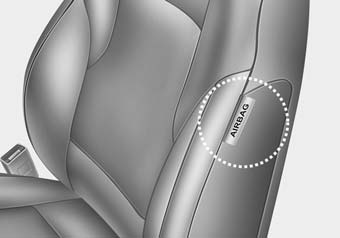
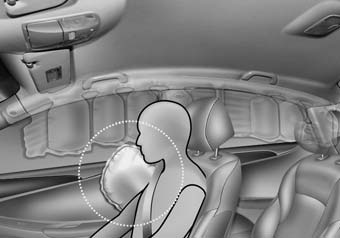
Your vehicle is equipped with a side impact air bag in each front seat. The purpose of the air bag is to provide the vehicle's driver and/or the front passenger with additional protection than that offered by the seat belt alone.
The side impact air bags are designed to deploy only during certain side-impact collisions, depending on the crash severity, angle, speed and point of impact. The side impact air bags are not designed to deploy in all side impact situations.
WARNING
• The side impact air bag is supplemental to the driver's and the passenger's seat belt systems and is not a substitute for them. Therefore your seat belts must be worn at all times while the vehicle is in motion. The air bags deploy only in certain side impact conditions severe enough to cause significant injury to the vehicle occupants.
• For best protection from the side impact air bag system and to avoid being injured by the deploying side impact air bag, both front seat occupants should sit in an upright position with the seat belt properly fastened. The driver's hands should be placed on the steering wheel at the 9:00 and 3:00 positions. The passenger's arms and hands should be placed on their laps.
• Do not use any accessory seat covers.
• Use of seat covers could reduce or prevent the effectiveness of the system.
• Do not install any accessories on the side or near the side air bag.
• Do not place any objects over the air bag or between the air bag and yourself.
• Do not place any objects (an umbrella, bag, etc.) between the front door and the front seat. Such objects may become dangerous projectiles and cause injury if the supplemental side air bag inflates.
• To prevent unexpected deployment of the side impact air bag that may result in personal injury, avoid impact to the side impact sensor when the ignition switch is on.
• If the seat or seat cover is damaged, have the vehicle checked and repaired by an authorized HYUNDAI dealer because your vehicle is equipped with side impact air bags and an occupant classification system.
Curtain air bag
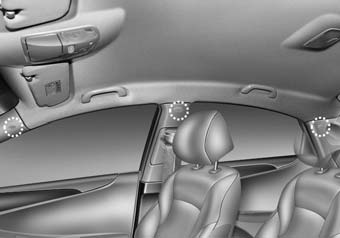
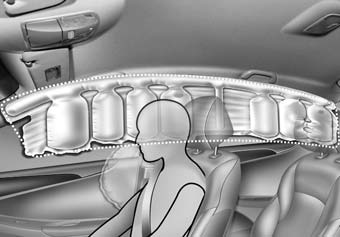
Curtain air bags are located along both sides of the roof rails above the front and rear doors.
They are designed to help protect the heads of the front seat occupants and the rear outboard seat occupants in certain side impact collisions.
The curtain air bags are designed to deploy only during certain side impact collisions, depending on the crash severity, angle, speed and impact. The curtain air bags are not designed to deploy in all side impact situations, collisions from the front or rear of the vehicle or in most rollover situations.
WARNING
• In order for side and curtain air bags to provide the best protection, front seat occupants and outboard rear occupants should sit in an upright position with the seat belts properly fastened. Importantly, children should sit in a proper child restraint system in the rear seat.
• When children are seated in the rear outboard seats, they must be seated in the proper child restraint system. Make sure to put the child restraint system as far away from the door side as possible, and secure the child restraint system in a locked position.
• Do not allow the passengers to lean their heads or bodies onto doors, put their arms on the doors, stretch their arms out of the window, or place objects between the doors and passengers when they are seated on seats equipped with side and/or curtain air bags.
• Never try to open or repair any components of the side curtain air bag system. This should only be done by an authorized HYUNDAI dealer.
Failure to follow the above instructions can result in injury or death to the vehicle occupants in an accident.
Why didn’t my air bag go off in a collision? (Inflation and non-inflation conditions of the air bag)
There are many types of accidents in which the air bag would not be expected to provide additional protection.
These include rear impacts, second or third collisions in multiple impact accidents, as well as low speed impacts. In other words, just because your vehicle is damaged and even if it is totally unusable, don’t be surprised that the air bags did not inflate.
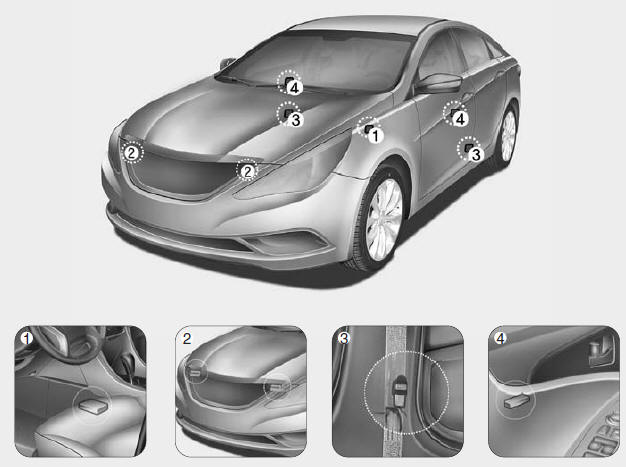
Air bag collision sensors
(1) SRS control module
(2) Front impact sensor
(3) Side impact sensor
(4) Side pressure sensor
WARNING
• Do not hit or allow any objects to impact the locations where air bags or sensors are installed. This may cause unexpected air bag deployment, which could result in serious personal injury or death.
• If the installation location or angle of the sensors is altered in any way, the air bags may deploy when they should not or they may not deploy when they should, causing severe injury or death. Therefore, do not try to perform maintenance on or around the air bag sensors. Have the vehicle checked and repaired by an authorized HYUNDAI dealer.
• Problems may arise if the sensor installation angles are changed due to the deformation of the front bumper, body or B pillars or front door where side collision sensors are installed. Have the vehicle checked and repaired by an authorized HYUNDAI dealer.
• Your vehicle has been designed to absorb impact and deploy the air bag(s) in certain collisions. Installing bumper guards or replacing a bumper with non-genuine parts may adversely affect your vehicle’s collision and air bag deployment performance.
Air bag inflation conditions
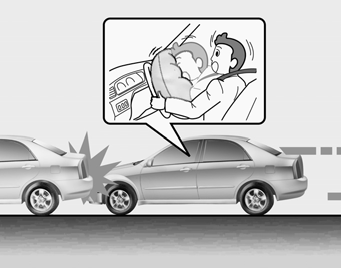
Front air bags
Front air bags are designed to inflate in a frontal collision depending on the intensity, speed or angles of impact of the front collision.
Side impact and curtain air bags
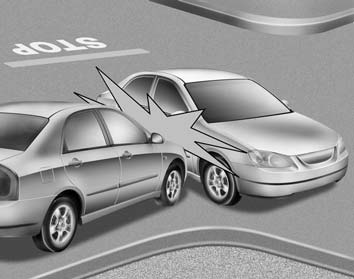
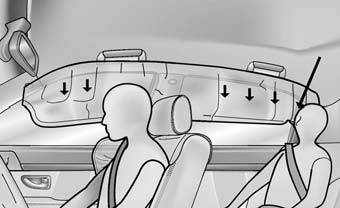
Side impact and curtain air bags are designed to inflate when an impact is detected by side collision sensors depending on the strength, speed or angles of impact resulting from a side impact collision.
Although the front air bags (driver’s and front passenger’s air bags) are designed to inflate only in frontal collisions, they also may inflate in other types of collisions if the front impact sensors detect a sufficient impact. Side impact and curtain air bags are designed to inflate only in side impact collisions, but they may inflate in other collisions if the side impact sensors detect a sufficient impact.
If the vehicle chassis is impacted by bumps or objects on unimproved roads, the air bags may deploy. Drive carefully on unimproved roads or on surfaces not designed for vehicle traffic to prevent unintended air bag deployment.


